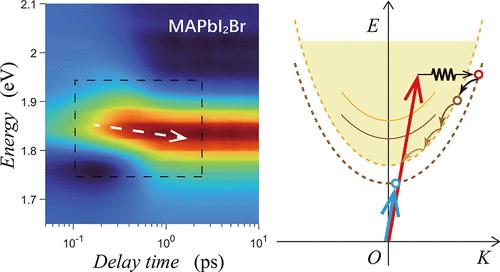当前位置:
X-MOL 学术
›
ACS Photonics
›
论文详情
Our official English website, www.x-mol.net, welcomes your
feedback! (Note: you will need to create a separate account there.)
New Insights into Hot-Charge Relaxation in Lead Halide Perovskite: Dynamical Bandgap Change, Hot-Biexciton Effect, and Photo-Bleaching Shift
ACS Photonics ( IF 6.5 ) Pub Date : 2022-06-14 , DOI: 10.1021/acsphotonics.2c00287 Kezhou Fan 1 , Christopher Chang Sing Chan 1 , Ligang Yuan 2 , Keyou Yan 2 , Kam Sing Wong 1
ACS Photonics ( IF 6.5 ) Pub Date : 2022-06-14 , DOI: 10.1021/acsphotonics.2c00287 Kezhou Fan 1 , Christopher Chang Sing Chan 1 , Ligang Yuan 2 , Keyou Yan 2 , Kam Sing Wong 1
Affiliation

|
Harnessing hot-charge relaxation in lead halide perovskites (LHPs) is the key to developing next-generation high-performance concentrator solar cells that break the Shockley–Queisser limit. Though the physical origins of the slow hot-carrier cooling and their interplays have been unveiled, consensus is still lacking concerning the mechanisms of many-body interactions during hot-charge relaxation. Here, we propose a unified theory to explain the spectral and temporal evolution of the band edge in LHPs at the early time-scale following femtosecond laser excitation. We demonstrate that at early times, the hot-biexciton effect imposes a transient bandgap shrinkage decaying rapidly with exciton dissociation. Subsequently, bandgap renormalization (BGR) effect dominates the bandgap change, with a partial compensation by the free-carrier Stark (FCS) effect. Additionally, we confirmed that the shift in the photo-bleaching (PB) peak in the transient absorption (TA) spectra is modulated by carrier temperature rather than the bandgap change, which has negligible influence on the bleaching position, contrary to previous studies. Importantly, this work demonstrates the significant role played by the hot-biexciton interaction to the exciton generation-dissociation and carrier relaxation dynamics in perovskite solar cell materials at early times. Our insights resolve the existing contradictions on the nature of early-time photo-induced absorption and PB shift via reliable quantifications. By unraveling the role of hot-charge cooling and the intricate many-body interactions among the hot-biexciton interplay, BGR and FCS effects, our study contributes to a deeper comprehension of the fundamental photo-physics in LHPs.
中文翻译:

对卤化铅钙钛矿热电荷弛豫的新见解:动态带隙变化、热双激子效应和光漂白位移
利用卤化铅钙钛矿 (LHP) 中的热电荷弛豫是开发突破 Shockley-Queisser 极限的下一代高性能聚光太阳能电池的关键。尽管已经揭示了缓慢热载流子冷却的物理起源及其相互作用,但关于热电荷弛豫过程中多体相互作用的机制仍然缺乏共识。在这里,我们提出了一个统一的理论来解释飞秒激光激发后早期时间尺度上 LHP 中带边缘的光谱和时间演变。我们证明,在早期,热双激子效应会导致瞬态带隙收缩随着激子解离而迅速衰减。随后,带隙重整化(BGR)效应主导带隙变化,通过自由载体斯塔克(FCS)效应进行部分补偿。此外,我们证实瞬态吸收 (TA) 光谱中光漂白 (PB) 峰的变化受载流子温度而不是带隙变化的调节,这与以前的研究相反,对漂白位置的影响可以忽略不计。重要的是,这项工作证明了热双激子相互作用在早期钙钛矿太阳能电池材料中对激子产生-解离和载流子弛豫动力学的重要作用。我们的见解通过可靠的量化解决了关于早期光致吸收和 PB 偏移性质的现有矛盾。通过揭示热充冷却的作用以及热双激子相互作用、BGR 和 FCS 效应之间复杂的多体相互作用,
更新日期:2022-06-14
中文翻译:

对卤化铅钙钛矿热电荷弛豫的新见解:动态带隙变化、热双激子效应和光漂白位移
利用卤化铅钙钛矿 (LHP) 中的热电荷弛豫是开发突破 Shockley-Queisser 极限的下一代高性能聚光太阳能电池的关键。尽管已经揭示了缓慢热载流子冷却的物理起源及其相互作用,但关于热电荷弛豫过程中多体相互作用的机制仍然缺乏共识。在这里,我们提出了一个统一的理论来解释飞秒激光激发后早期时间尺度上 LHP 中带边缘的光谱和时间演变。我们证明,在早期,热双激子效应会导致瞬态带隙收缩随着激子解离而迅速衰减。随后,带隙重整化(BGR)效应主导带隙变化,通过自由载体斯塔克(FCS)效应进行部分补偿。此外,我们证实瞬态吸收 (TA) 光谱中光漂白 (PB) 峰的变化受载流子温度而不是带隙变化的调节,这与以前的研究相反,对漂白位置的影响可以忽略不计。重要的是,这项工作证明了热双激子相互作用在早期钙钛矿太阳能电池材料中对激子产生-解离和载流子弛豫动力学的重要作用。我们的见解通过可靠的量化解决了关于早期光致吸收和 PB 偏移性质的现有矛盾。通过揭示热充冷却的作用以及热双激子相互作用、BGR 和 FCS 效应之间复杂的多体相互作用,











































 京公网安备 11010802027423号
京公网安备 11010802027423号